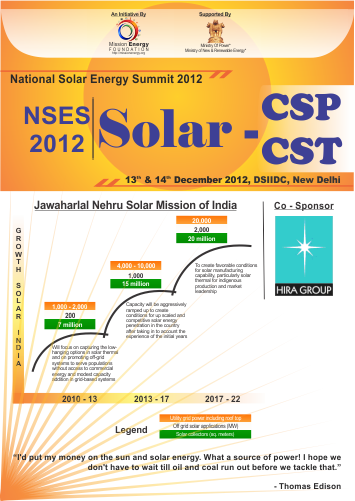
Preamble
Energy is considered a prime agent in the generation of wealth and a significant factor in economic development. Limited fossil resources and environmental problems associated with them have emphasized the need for new sustainable energy supply options that use renewable energies. Solar thermal power generation systems also known as Solar Thermal Electricity (STE) generating systems are emerging renewable energy technologies and can be developed as viable option for electricity generation in future. The National Solar Energy Summit 2012 (NSES 2012) is the most comprehensive summit that discusses the technology options, their current status and opportunities and challenges in developing solar thermal power plants in the context of India.
India's Power Scenario
India's current electricity installed capacity is 200 GW, the world's fifth largest. Currently there is peak power shortage of about 10 % and overall power shortage of 7.5 %.
The Eleventh Plan had targeted creation of 78.7 GW of additional capacity for grid power. Actual realisation may not exceed 50 GW, largely on account of slippages in public sector projects. The shortfall in achieving the targets has been primarily due to poor project implementation, inadequate domestic manufacturing capacity, shortage of power equipment, and slow-down due to lack of fuel, particularly coal. According to the Approach to the 12th Five-Year Plan, the commission is eyeing a power capacity creation of about 88,000 MW in the five years as the sector battles acute fuel shortage.
Solar Energy Potential
India with abundant sunshine is an ideal location to develop solar energy. The technology is constantly being upgraded and like wind energy it is estimated new solar technology too will achieve grid parity soon with conventional energy sources. Still solar energy has been grossly underutilized in India. On an average most parts of our country receive 300 days of strong sun light. It has been estimated that this sunshine results in 200 MW/km2 of energy every hour and 12.5 per cent of India's landmass can be used to harness this natural source of renewable energy.
At the end of August 2011 India's installed solar power capacity was 46.16 MW and it was powered entirely by PV technology. However, grid connected solar power accounts for only 12.58 MW or 0.07 per cent of the total grid connected renewable power capacity that stands at 20 million MW. Off grid and de-centralised solar power projects fared better. Both private as well as public sector undertakings have started investing in STP. Foreign companies have invested $ 55 million and NTPC is developing a 10 MW plant in Rajasthan and a 25 MW in Uttar Pradesh. Other STP projects approved for Gujarat and Rajasthan will generate another 381 MW. As far as solar water heating is concerned the total installed capacity as on June 2010 was a little over 3.5 million m2 where as the potential stands at 40 million m2. The government has set a target of increasing this capacity to 20 million m2 by 2022
An Initiative By

Ministry of Power*
Ministry of New & Renewable Energy*
Supported By
Co - Sponsor









